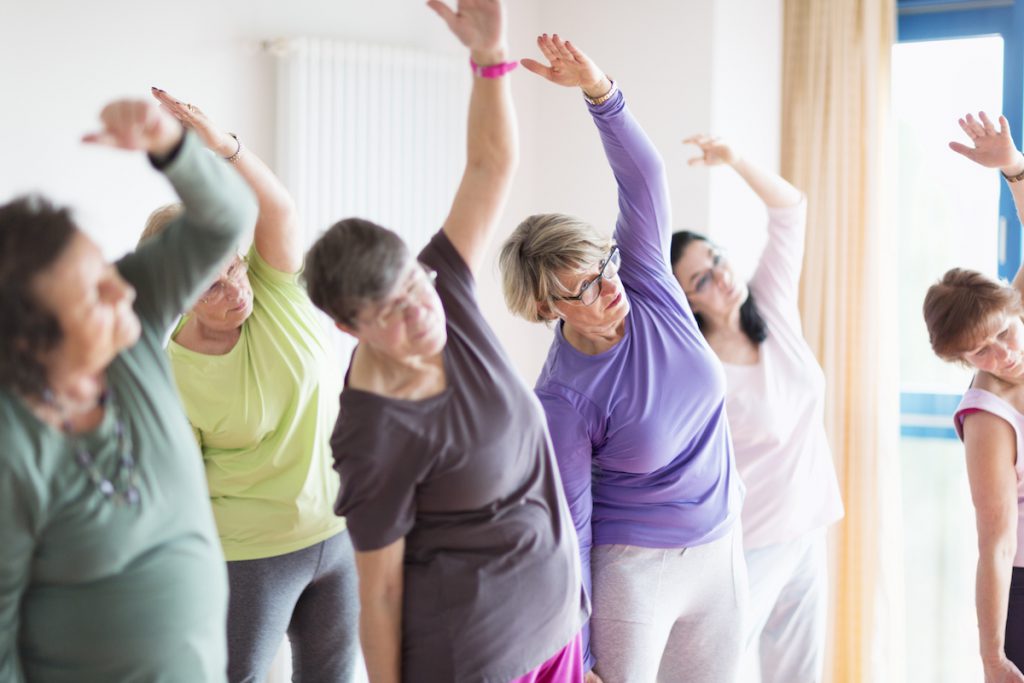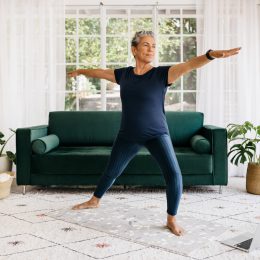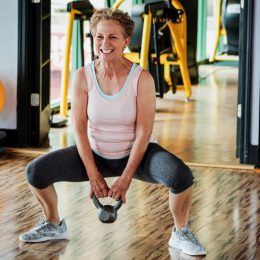10 indicaciones de fitness comunes que debería ignorar, según los fisioterapeutas
¿Alguna vez escuchó de estas indicaciones? Es posible que sean más perjudiciales que beneficiosas. Here's what to do instead.

You know those fitness cues you hear from personal trainers and fitness coaches — like “tighten your core,” “tuck your tailbone,” or “pinch your shoulder blades together”?
They’re meant to aid in proper technique, but some (including the three we just mentioned) can actually have the opposite effect, setting you up for poor results or even injury.
As movement experts, physical therapists zero in on these problematic cues and come up with more effective ones to teach moves in a different way.
"No one cue will work for every single person," says Jessica Curran, P.T., D.P.T., O.C.S., clinical manager and physical therapist at the Shirley Ryan AbilityLab. "It's all about personalizing it. That's something we learn with experience."
Curran likes to empower her patients to pay attention to their bodies and learn from their own movements.
"At the end of the day, it's not all about what I see," Curran says. "What do you see? How does it make sense to you?"
A physical therapist or your SilverSneakers instructor can help guide you through that process.
In the meantime, don't get thrown off by any of these common, tricky fitness cues. Take the advice of physical therapists to make each exercise right for you.
1. “Reach for your toes”
This cue — often used for a hamstring stretch — is likely to make you round your back, says Sherri Betz, P.T., D.P.T., a board-certified specialist in geriatric physical therapy and owner of TheraPilates.
That puts stress on the vertebrae most at risk for fracture in those with osteoporosis or osteopenia, Betz says. That's not good, considering about half of older adults over 50 have low bone density, Betz says.
"When I teach a hamstring stretch, I recommend that teachers put their hands on their hips rather than reach for their toes," Betz says. That simple tweak can help cue good spinal alignment.
A good tactile cue is to ask a partner to place a dowel or broomstick behind you so it touches your head, midback, and butt, Betz says. Keeping those three points of contact as you bend forward helps protect you from rounding your back.
SilverSneakers instructors are specially trained in senior fitness. Priorizan ejercicios que son seguros, efectivos y pueden ayudarle a desplazarse por la vida con más facilidad. Check your eligibility here. Find participating locations here. And view the current SilverSneakers LIVE schedule here.
2. “Tighten your core”
Trainers often use this cue to get people to engage their abdominals during core moves.
But if you overtighten your abs, you may end up rounding your back or even pressing on the pelvic floor, creating the potential for urinary incontinence, Betz says.
Besides, if you simply perform exercises correctly with good form, your abs will naturally kick in, Betz says. "Once you get your body in the right alignment, the right muscles will work."
See for yourself: Sit in a chair and let your head move forward slightly. Now pull your head back so you're sitting tall with good posture.
Feel the difference in your abs?
"If you sit up tall, your abdominal wall should be tight without you telling it to tighten," Betz says. "Then if you lean your head forward a little, what happens to your belly? It softens. It turns off."
Recommended reading: 7 Genius Form Fixes That Physical Therapists Wish You Knew
3. “Squeeze!”
Often trainers will tell you to squeeze your targeted muscles to get more contraction during moves. Not only could that prompt you to over-contract your muscle, causing cramps, but it's also not an effective way to build strength, Betz says.
"I heard a person say 'Squeeze your calves' during a heel raise," Betz recalls. "Why? Keep your knee straight, spine lengthened, rise up as high as you can go, and lower slowly down. That's going to give you maximum contraction."
If you want to increase the challenge, try adding weight, Betz suggests. "When you can do 15 reps in a row, then you add weight to improve strength."
Use a light dumbbell, a water jug, or a bag of flour, Betz says. "That's a great thing to do," Betz says. "It's very functional."
Recommended reading: 5 Better Ways to Get Stronger, According to Physical Therapists
4. “Tuck your tailbone under”
This cue, common in barre workouts, is meant to get you to posteriorly tilt your pelvis, so the front of the pelvis rises and the back drops.
But that's not appropriate for standing or forward-bending moves, Betz says. "It would encourage rounding and flexion in the lumbar spine."
It is far better to lift your tailbone to keep a natural, inward curve in your lower back, says Betz. She uses the cues “keep your chest up” and “stick the tail feathers up” when instructing the hip hinge.
5. “No pain, no gain”
Some pain (muscle burn) is normal during exercise, but other pain (sharp, shooting, stabbing) may be a warning sign.
Alexis DiClemente, P.T., D.P.T., an orthopedic clinical specialist at the Hospital for Special Surgery, teaches her patients the difference.
Those patients often fall into two camps: One is the "no pain, no gain" type who's highly motivated and ready to go hard. The other type shies away from exercise because they're living with arthritis or some other chronic pain condition and they fear getting hurt.
“People hear the terms ‘degenerative’ and ‘arthritis’ and they think their bones are brittle and their joints are weak, and they shouldn’t exercise,” DiClemente says.
Not true — in fact, regular exercise can actually reduce joint pain from osteoarthritis.
You don't want to fear exercise, but you don't want to overdo it either. The key is finding the right program that challenges you but still keeps you safe.
SilverSneakers fitness classes are taught by certified instructors who are specially trained in the fitness needs of older adults. Let them know your physical limitations and they can help you modify exercises safely. Learn more about what makes our classes and instructors unique by reading 5 Things SilverSneakers Instructors Know That Other Trainers Don’t.
DiClemente’s traffic-light system is a guideline for pain that she shares with her patients:
- Green light: Feel a bit of stretching discomfort, or muscle burning, soreness, or fatigue? That’s normal and safe — keep going.
- Yellow light: If you start to feel sharp, shooting, stabbing, or throbbing pain in your joints that’s a 6 or 7 on a 1-to-10 pain scale, rest for 30 to 60 seconds and try the exercise again, DiClemente suggests.
- Red light: If the pain stays at a 6 or 7 even after you’ve rested, stop. Consult a physical therapist to see if they can prescribe exercises to help you do the activity you want to do.
6. “Never let your knees go past your toes”
We've all heard this instruction before, whether for a lunge or a squat. But in fact, it's perfectly safe for your knees to track past your toes, says Ryan Coxe, P.T., a physical therapist at Shirley Ryan AbilityLab.
“We do it every day,” Coxe says, “whether you’re standing up from a low chair or you’re leaning down to pick something up, your knees are designed to go in front of your toes.”
If you actively try to avoid the motion, you may end up developing unhealthy habits, Coxe notes. "You're going to use your back and hips a lot more," Coxe says. Plus, if you need to recover your balance but won't let your knees pass your toes, you may sustain a fall, Curran says.
On the other hand, driving the knee past the toes is often a compensatory strategy for a weak “posterior chain” (the muscles along the backside of the body like the back extensors, glutes, and hamstrings), says DiClemente.
It can also trigger pain for those with knee arthritis, she adds.
A better cue: "Keep your weight in your heels," Clemente says. This ensures that you'll activate the posterior chain, even if your knees do move forward a bit.
Another squat cue that physical therapists love: "Pretend like you're sitting in a chair." It's functional and relatable, and will activate that posterior chain, Clemente says.
7. “Drop lower”
Trainers often encourage you to go deep into a squat or lunge. But keeping the squat controlled is more important than the depth, Coxe says.
“Controlling the move is super important for decreasing risk for injury and just staying productive,” Coxe says.
Suscríbase a nuestro boletín informativo
Es rápido y fácil: Usted podría estar entre las 13 millones de personas elegibles.
¿Ya es miembro? Haga clic para descubrir nuestros más de 15,000 centros participantes.
Síganos
"Check in with yourself," Curran recommends. "What do you feel?"
If your abs, quads, and butt muscles are working, you’re good. If not, maybe you can drop a little lower. (Squatting with a chair behind you can give you a fail-safe.) But don’t feel you must drop low to get a benefit, especially if you’re feeling any pain or unsteadiness.
What’s right for you depends on not just your mobility and strength but also your goal, Curran says.
For example, if your goal is to be able to stand up from a chair while holding your grandchild, it might be more appropriate to increase the challenge by adding weight versus dropping lower.
A physical therapist can help you come up with a workout plan suited to your unique goals.
Recommended reading: 5 Surprising Reasons to See a Physical Therapist
8. “Drop your butt”
When you're in a plank position, your body should form a straight line from head to heels. If your butt sticks up too high, a trainer might cue you to lower it.
But odds are your core is simply too weak to maintain that straight line, and you could end up lowering your hips too far, stressing the lower back, Curran says.
A better strategy is to regress the move by performing it on your knees.
"That can still be very engaging for your core," Coxe says. "Just because you regress the exercise doesn't mean it's any less beneficial." On the other hand, if you do the plank incorrectly, you're not benefiting at all, Curran says.
Press play on this video to learn safe plank variations:
9. “Pinch your shoulder blades together”
You may hear this when a trainer is trying to set you up with good posture before a pulling move, like a row.
But often, people respond by shrugging their shoulders. Not good.
"You are over-utilizing your trapezius muscles, which is not the intention of this cue," Curran says. "The cue is meant to improve your posture and strengthen the muscles on your back."
Instead, bring your shoulder blades together and down, not up, Curran says. This will improve your posture and engage the right back muscles, Curran says.
10. “Keep the pace” or “keep the tempo”
If you have an instructor who prescribes a pace during workouts, don’t sacrifice proper form so you can keep up.
That happened to one of DiClemente's patients who does a group exercise class. "We've talked about having her do 1 repetition for every 2 that the instructor does," DiClemente says, "because when she starts to quicken her pace, her form goes out the window."
Poor form can trigger back pain or even cause injury, DiClemente says.
Go only as fast as you can while maintaining good form — whatever that pace is for you.
¡Tome en línea sus clases favoritas de SilverSneakers!
SilverSneakers members can access live fitness classes and wellness workshops through SilverSneakers LIVE. See the latest schedule and RSVP for classes here.
Not a member? If you have a Medicare Plan, it may include SilverSneakers — at no additional cost. Check your eligibility instantly here.





